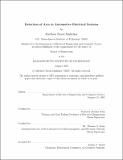Detection of arcs in automotive electrical systems
Author(s)
Mishrikey, Matthew David
DownloadFull printable version (1.194Mb)
Other Contributors
Massachusetts Institute of Technology. Dept. of Electrical Engineering and Computer Science.
Advisor
Markus Zahn and Thomas A. Keim.
Terms of use
Metadata
Show full item recordAbstract
At the present time, there is no established method for the detection of DC electric arcing. This is a concern for forthcoming advanced automotive electrical systems which consist of higher DC electric power bus voltages, such as the automotive industry proposed 42 volt standard. At these higher voltages, wire faults can lead to stable electric arcs, which may hazardously cause insulation to catch on fire. This thesis presents the results of investigations of phase noise and broadband emissions as indicators of DC electric arcing. We have developed a broadband emissions system based detection system. A proof-of-concept implementation of such a detector indicated favorable results in a laboratory simulated arcing environment, and in a vehicle. Suggestions for robust detection in a noisy environment are presented. Keywords: 42v, 42 volt, arcing, automotive, broadband, DC, detection, electric, emissions, harness, phase noise, RF
Description
Thesis (M. Eng.)--Massachusetts Institute of Technology, Dept. of Electrical Engineering and Computer Science, 2005. This electronic version was submitted by the student author. The certified thesis is available in the Institute Archives and Special Collections. Includes bibliographical references (p. 91-92).
Date issued
2005Department
Massachusetts Institute of Technology. Department of Electrical Engineering and Computer SciencePublisher
Massachusetts Institute of Technology
Keywords
Electrical Engineering and Computer Science.